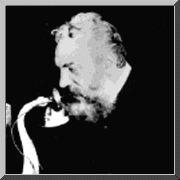 Alexander
Graham Bell, was born on March 3, 1847 in Edinburgh,
Scotland. He attended the University of Edinburgh and the University
of London. He moved to Canada in 1870 and the United States of
America in 1871. In 1872 Bell founded a school for the deaf in
Boston. The school became part of Boston University, where Bell was a
professor of vocal physiology. He became an American citizen in
1882.
Alexander
Graham Bell, was born on March 3, 1847 in Edinburgh,
Scotland. He attended the University of Edinburgh and the University
of London. He moved to Canada in 1870 and the United States of
America in 1871. In 1872 Bell founded a school for the deaf in
Boston. The school became part of Boston University, where Bell was a
professor of vocal physiology. He became an American citizen in
1882.
In 1876 developed the first working telephone and transmitted his now famous quotation "Watson, come here, I want you." His telephone was introduced on a large scale at the Philadelphia Centennial Exposition in 1877. The Bell Telephone Company was founded the next year.
In addition to the telephone, Bell is credited with the invention of the phonograph, the photo phone (which transmits speech by light rays), the audiometer (used to measuring hearing acuity), the induction balance (used to locate metal objects in the human body), and the first beeswax recording cylinder (ancestor of the phonograph record). Later in his life, he developed a kite capable of carrying a person - the ancestor of the modern day hang glider. He also developed the world's fastest speed boat (capable of traveling at 70 miles per hour).
Alexander Graham Bell died on August 2, 1922 at Baddeck.
References
Asimov, I. (1964). Asimov's Biographical Encyclopedia of Science and Technology: The Living Stories of More than 1000 Great Scientists from the Age of Greece to the Space Age Chronologically Arranged. Garden City, NY: Doubleday.
Daintith, J., Mitchell, S., & Tootill, E. (1981). A Biographical Encyclopedia of Scientists. New York: Facts on File.
Howard, A.V. (1951). Chamber's Dictionary of Scientists. London: Chambers.
McGraw-Hill (1966). McGraw-Hill Modern Men of Science. New York: McGraw Hill.